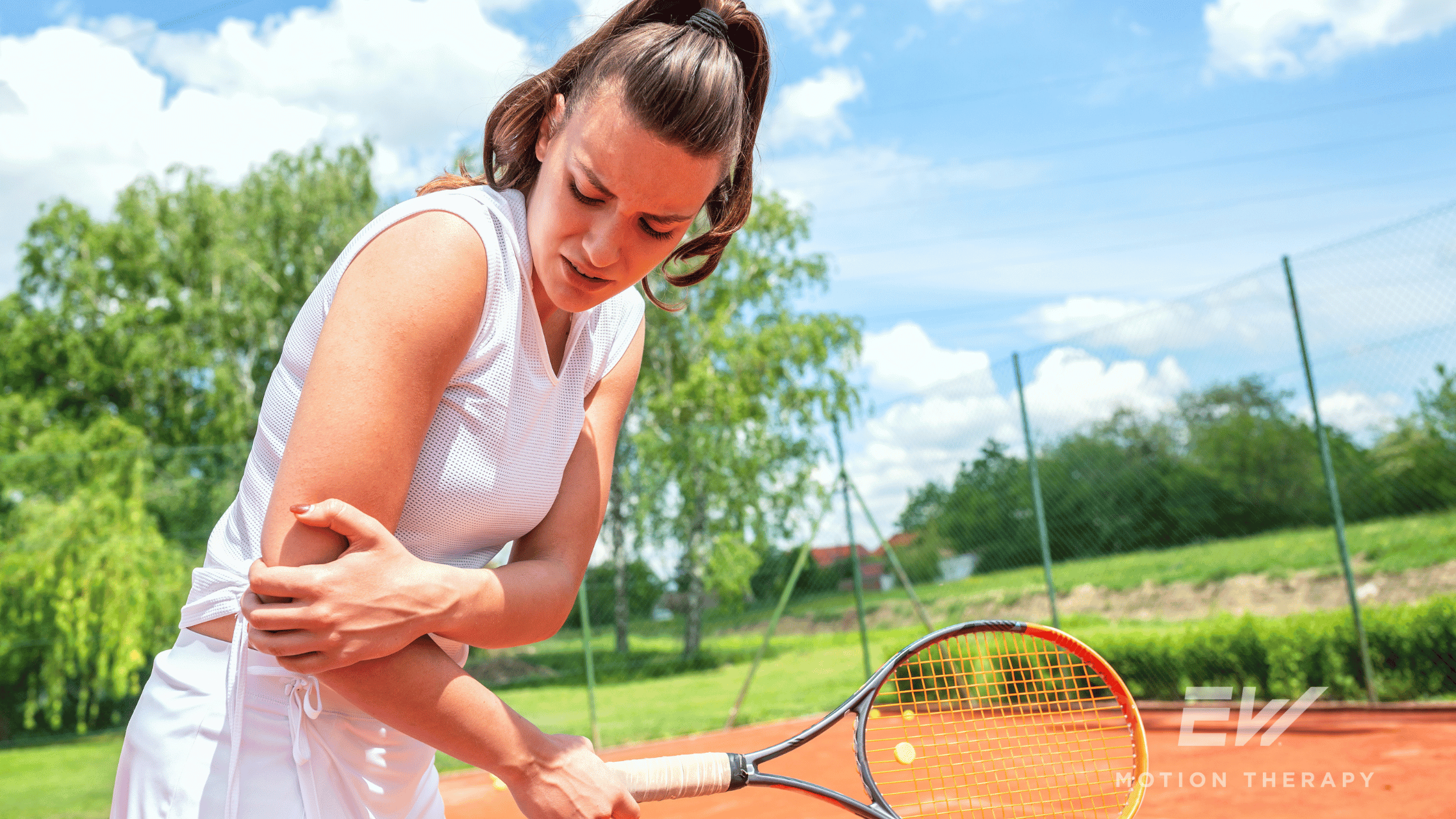Understanding Tennis Elbow: Causes, Symptoms, and Treatments

Licensed Physical Therapist, PT, DPT // EW Motion Therapy Meadowbrook/280
Tennis elbow, or lateral epicondylitis, is a type of tendonitis that affects not just tennis players but a wide range of individuals. It is characterized by pain and tenderness on the outside of the elbow, which can significantly impact one's ability to perform daily tasks or engage in sports. We consider it a privilege to help our athletes at EW Motion Therapy combat conditions like tennis elbow so they can continue to play the sport they love pain-free. Even if you decide that our physical therapy isn’t right for you, we will delve into why tennis elbow is so prevalent among tennis players in this article. We’ll also cover who else can be affected, the common causes and symptoms, its impact on a tennis player's game, and how physical therapy can be effective.
Why is tennis elbow common among tennis players?
Tennis elbow is particularly common among tennis players due to the sport's repetitive motion and high-stress demands. The condition is caused by the overuse of the forearm muscles and tendons, which can become damaged from repeated gripping, lifting, and swinging actions. The backhand stroke, in particular, puts a significant strain on the muscles and tendons around the elbow joint.
When a player repeatedly hits the ball with improper technique or uses equipment that doesn't suit their body mechanics, they are more likely to develop tennis elbow. The small tears that develop in the tendons can lead to inflammation, pain, and weakness, making it difficult to grip and lift objects.
Who else can be affected by tennis elbow?
While tennis players are often associated with this condition, tennis elbow is not exclusive to them. Anyone who engages in repetitive arm and wrist activities can develop tennis elbow. This includes:
- Manual laborers: Carpenters, plumbers, and painters often use their forearm muscles extensively, leading to a higher risk of developing tennis elbow.
- Office workers: Individuals who spend a lot of time typing or using a computer mouse can experience similar repetitive strain.
- Musicians: String instrument players, drummers, and pianists can develop tennis elbow due to repetitive movements and the constant use of their forearm muscles.
- Athletes in other sports: Sports like squash, badminton, golf, and even weightlifting can contribute to the development of tennis elbow.
Common causes and symptoms of tennis elbow
The primary cause of tennis elbow is overuse of wrist extension and repetitive motion. Other contributing factors include:
- Improper technique: Using incorrect form during activities can place undue stress on the forearm muscles and tendons.
- Weak muscles: Weak shoulder and wrist muscles, along with decreased range of motion in the shoulder, can lead to increased strain on the elbow.
- Inadequate equipment: Using equipment unsuited to one's body mechanics, such as a racquet with improper string tension or the wrong grip size, can contribute to the condition.
- Lack of conditioning: Failing to properly warm up and stretch before engaging in activities can increase the risk of injury.
The symptoms of tennis elbow can vary but generally include:
- Pain and tenderness: Pain on the outside of the elbow that may radiate down the forearm or pain with wrist or finger extension.
- Weakness: Difficulty in gripping or lifting objects, which can affect daily tasks.
- Stiffness: Stiffness in the elbow joint, especially in the morning or after periods of inactivity.
- Swelling: In some cases, mild swelling can occur around the elbow.
How tennis elbow affects a tennis player's game
Tennis elbow can be a significant hindrance for tennis players. The pain and weakness associated with the condition can affect most wrist movements, reducing their ability to grip the racquet firmly and affecting their control and power during play. One-handed backhand strokes can become particularly challenging, and the player may experience a noticeable decrease in performance.
In severe cases, the pain may be so intense that it becomes difficult to play at all, leading to time away from the sport. This not only impacts their physical fitness but also their mental well-being, as the frustration of being unable to play can take a toll.
How physical therapy can help
Physical therapy is a highly effective treatment for tennis elbow. A tailored physical therapy program can help reduce pain, improve function, and prevent recurrence. Your therapist will assess all upper body strength and mobility, along with core stability, to try and determine how the injury occurred so they can treat the root cause. Here are some other ways physical therapy can make a difference:
Pain management
Therapists use a variety of techniques to manage pain, including:
- Manual therapy: Hands-on techniques to mobilize the joints and soft tissues.
- Ice and heat therapy: To reduce inflammation and alleviate pain.
- Dry needling: To target trigger points and improve muscle health and performance.
Strengthening and stretching exercises
A crucial aspect of physical therapy for tennis elbow is strengthening the muscles and tendons around the elbow. This helps to:
- Reduce strain: Strengthening the forearm, wrist, and shoulder muscles can reduce the load on the elbow tendons.
- Improve flexibility: Stretching exercises can help improve flexibility and reduce stiffness, making movements smoother and less painful.
- Reduce pain: Your therapist can recommend elbow bracing and help with Kinesio taping (KT tape) to relieve pain in movement.
Technique and equipment assessment
Physical therapists can also assess a player's technique and recommend adjustments to reduce strain on the elbow. This might involve:
- Analyzing stroke mechanics: Changing how the player grips and swings the racquet.
- Recommending equipment changes: Advising on racquet specifications, such as grip size and string tension, to better suit the player’s needs.
Gradual return to activity
One key goal of physical therapy is to help players safely return to their sport. Therapists develop a gradual return plan, ensuring that the player increases their activity level progressively to avoid re-injury. Your therapist will also monitor your progress through regular check-ins to adjust the treatment plan as needed.
Tennis elbow is a common but manageable condition that affects not only tennis players but also individuals who engage in repetitive arm and wrist activities. Understanding the causes, symptoms, and impacts of tennis elbow is crucial for effective treatment and prevention. Physical therapy offers a comprehensive approach to managing tennis elbow, focusing on pain relief, strengthening, and technique adjustment to help individuals return to their activities pain-free and stronger than before.
By addressing the root causes and implementing targeted treatment strategies, physical therapy can significantly improve outcomes for those suffering from tennis elbow, ensuring they can continue to engage in their favorite activities without discomfort. Getting our athletes back to their sport as soon as possible without pain is our ultimate goal at EW Motion Therapy - our physical therapists create custom treatment plans and use different interventions like dry needling to accomplish this. If you’re curious about how much your physical therapy treatment may cost, click the button below to download our free pricing guide.


